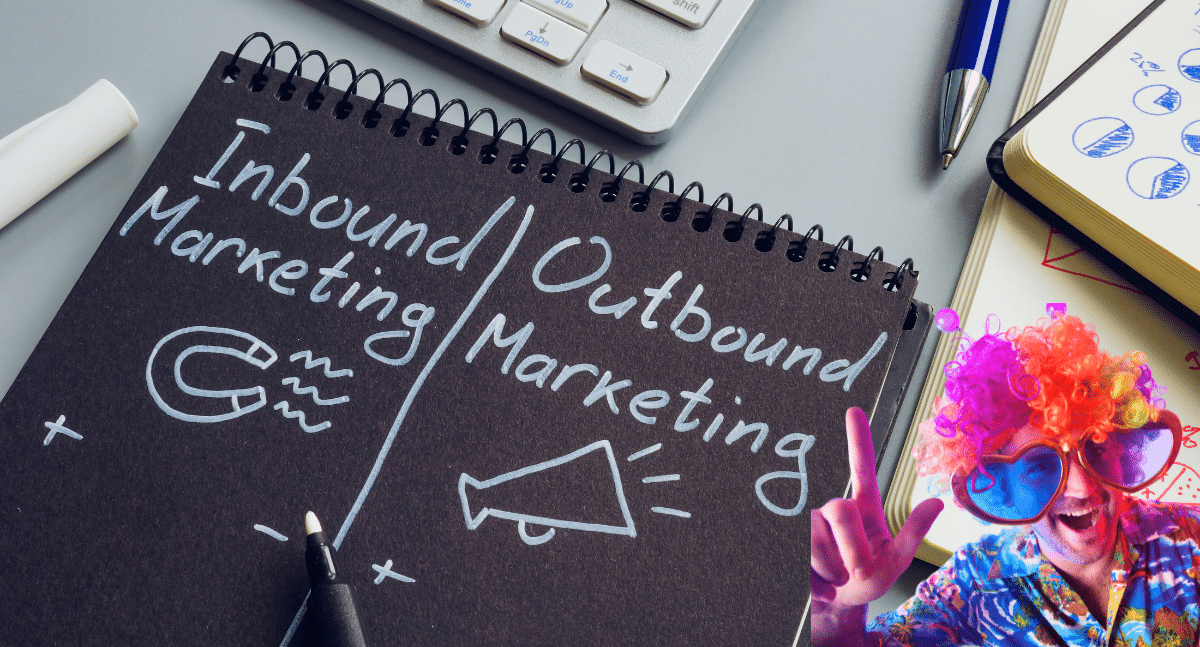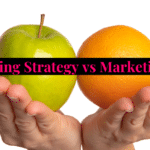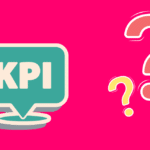The debate between inbound and outbound marketing has been raging on for quite some time now.
On one hand, inbound marketing advocates argue that creating valuable content and building a strong online presence is the key to attracting potential customers.
And on the other hand, outbound marketing proponents believe that a more direct approach, such as cold calling or advertising, is the way to go.
But, what’s the right strategy for your business?
Today, we’ll delve into the nuances of inbound and outbound marketing to help you determine which approach is best suited to your needs.
We’ll examine their core principles, compare their strengths and weaknesses, and provide examples of how each can be applied in real-world scenarios.
Let’s dive in and settle this debate, well, try to.
Understanding the Core Principles of Inbound and Outbound Marketing

Very simply, Inbound and outbound marketing are two different approaches to reaching potential customers.
Each has its own core principles and strategies.
In this section, we’ll break down the fundamentals of each, giving you a clear understanding of what sets them apart and how they can be effectively utilized in your marketing efforts.
Starting with inbound.
1. Inbound Marketing

Inbound marketing is a customer-centric approach that focuses on creating and sharing valuable content to attract and engage a specific audience.
The goal is to build trust and establish relationships with potential customers, ultimately leading to sales and brand loyalty.
Core Principles of Inbound Marketing:
- Attract: Create valuable content and experiences tailored to your target audience’s needs and interests. Use SEO and social media to make your content easily discoverable.
- Engage: Interact with your audience through personalized communication channels, such as email, chat, and social media. Provide relevant and timely information to address their pain points.
- Delight: Continue to provide value even after a purchase. Offer exceptional customer service and valuable resources to foster long-term relationships and turn customers into promoters.
Key Inbound Marketing Strategies:
- Content Marketing: Create and distribute valuable, relevant, and consistent content to attract and retain a clearly defined audience.
- Search Engine Optimization (SEO): Optimize your website and content to rank higher in search engine results, making it easier for potential customers to find you.
- Social Media Marketing: Use social platforms to engage with your audience, share content, and build relationships.
- Email Marketing: Nurture leads and maintain customer relationships through personalized email campaigns.
Let’s check out a few inbound marketing examples.
Straightforward Inbound Marketing Examples:
- Blogging: A company creates a blog post that addresses a common problem their target audience faces and provides a solution.
- Social Media Posts: A business shares an informative video on Facebook that educates viewers about a new product feature.
- SEO Optimization: An e-commerce site optimizes its product pages to rank higher in search engine results, making it easier for potential customers to find their products.
You can see that Inbound marketing focuses on creating a strong online presence and building relationships with potential customers. Ideally by providing them with valuable content and personalized experiences.
2. Outbound Marketing

Outbound marketing is a brand-centric approach that involves pushing a message to a large, general audience, in the hopes of reaching potential customers.
The goal is to create awareness and generate leads by promoting products or services through various channels.
Core Principles of Outbound Marketing:
- Push: Reach a broad audience with your message through traditional channels, such as TV, radio, print ads, and billboards.
- Interrupt: Capture attention by interrupting the audience’s current activity or environment with your message.
- Control: Have more control over the timing and delivery of your message, allowing you to reach a larger audience in a shorter period.
Key Outbound Marketing Strategies:
- Paid Advertising: Pay to have your message displayed to a target audience, either online (Google Ads, social media ads) or offline (TV, radio).
- Cold Calling: Reach out to potential customers who have not expressed interest in your product or service.
- Direct Mail: Send physical mail, such as postcards or flyers, to a targeted list of recipients.
- Trade Shows: Participate in industry-specific events to showcase your products or services to a relevant audience.
Outbound Marketing Examples:
TV Commercials: A company creates a 30-second commercial promoting their new product and airs it during a popular TV show.
Telemarketing: A call center makes unsolicited calls to individuals in a specific area, offering a discount on a service.
Print Ads: A local business places an ad in the newspaper, announcing a limited-time sale on their products.
Overall, outbound marketing focuses on pushing a message to a large audience, often through traditional channels, to create brand awareness and generate leads.
So, you’ve got a good idea of what both styles of marketing are, now let’s put them side by side and compare things, shall we?
The Pros and Cons of Inbound and Outbound Marketing

Now that we’ve covered the core principles and strategies of inbound and outbound marketing, let’s compare the strengths and weaknesses of each approach.
Understanding the pros and cons will help you make an informed decision on which strategy is the best fit for your business and marketing goals.
Let’s break things down a bit.
1. Cost

Inbound Marketing:
Pros: Inbound marketing is often more cost-effective than outbound marketing because it focuses on creating valuable content and building organic relationships.
While there may be initial costs associated with content creation and website optimization, the long-term benefits can outweigh the expenses.
Cons: It requires a significant time investment to produce high-quality content and build a strong online presence.
Outbound Marketing:
Pros: Outbound marketing allows for more control over the message’s timing and delivery. While there may be higher upfront costs associated with paid advertising or direct mail, the immediate reach and potential for quick results can be appealing.
Cons: It can be more expensive than inbound marketing, as it often involves paid advertising and other promotional efforts.
2. Targeting

Inbound Marketing:
Pros: Inbound marketing allows for precise targeting, as you can tailor your content to specific audience segments and use tools like SEO and social media to reach them.
Cons: It can be more difficult to reach a broader audience quickly, as inbound marketing focuses on attracting customers who are already interested in your products or services.
Outbound Marketing:
Pros: Outbound marketing can help you reach a larger audience in a shorter period, as it involves pushing a message to a broad audience.
Cons: The targeting may be less precise, as the message is often delivered to a general audience rather than a specific segment.
3. Effectiveness

Inbound Marketing:
Pros: Inbound marketing focuses on providing valuable content and building relationships, which can lead to more loyal customers and long-term success.
Cons: It may take longer to see results, as it can require time to build a strong online presence and attract a steady stream of customers.
Outbound Marketing:
Pros: Outbound marketing can generate quick results and create brand awareness, as the message is pushed to a broad audience.
Cons: It may be less effective at building long-term relationships with customers, as the focus is on reaching a large audience rather than providing personalized experiences.
4. Measurability

Inbound Marketing:
Pros: Inbound marketing is highly measurable, as you can track metrics like website traffic, keyword rankings, and social media engagement to gauge the success of your efforts.
Cons: It can be challenging to directly attribute sales or conversions to specific inbound marketing activities.
Outbound Marketing:
Pros: Outbound marketing can also be measurable, especially with digital channels like paid advertising, where you can track metrics like click-through rates and conversion rates.
Cons: It can be more difficult to measure the impact of traditional outbound marketing methods like TV commercials or direct mail.
5. Customer Relationships

Inbound Marketing:
Pros: Inbound marketing focuses on building relationships with customers by providing valuable content and personalized experiences.
Cons: It may take longer to establish these relationships, as it requires time to attract and engage with potential customers.
Outbound Marketing:
Pros: Outbound marketing can create brand awareness and reach a large audience, which can be beneficial for businesses looking to expand quickly.
Cons: It may be less effective at building strong, long-term relationships with customers, as the focus is on reaching a broad audience rather than providing personalized experiences.
I know what you’re thinking… (well I think I do)
“How can I create a killer marketing strategy utilizing both inbound an outbound marketing?”
Well, it goes a little something like this…
How to Create a Winning Marketing Strategy with Both Inbound and Outbound Marketing in 3 Simple Steps

Inbound and outbound marketing can be powerful strategies by themselves, but when used in tandem, they can be incredible.
1. Identify Your Target Audience
To create a successful marketing strategy, you must first understand your target audience.
This involves conducting market research to identify the demographics, preferences, and behaviors of your potential customers.
When using both inbound and outbound marketing, you can tailor your messaging to specific audience segments, ensuring that your content is relevant and engaging.
2. Create a Seamless Customer Journey
A seamless customer journey is essential for a successful marketing strategy.
This involves guiding potential customers through a series of touchpoints, from initial awareness to eventual purchase and beyond.
Inbound marketing can help attract and engage potential customers, while outbound marketing can create brand awareness and drive traffic to your website or social media channels.
3. Measure the Effectiveness of Your Efforts
To ensure your marketing strategy is working, it’s crucial to measure the effectiveness of your inbound and outbound efforts.
This involves tracking key performance indicators (KPIs) such as website traffic, lead conversion rates, and customer acquisition costs.
By analyzing these metrics, you can identify which marketing channels are performing well and make data-driven decisions to optimize your strategy.
And again, let’s wrap this up and grab some caffeine.
Wrap Up
In the debate between inbound and outbound marketing, there is no one-size-fits-all answer.
Both approaches have their strengths and weaknesses, and the best strategy for your business depends on your goals, target audience, and resources.
As we’ve explored in this article, inbound marketing focuses on creating valuable content and building relationships, while outbound marketing is more about reaching a broad audience and creating brand awareness.
When used together, these strategies can complement each other, creating a holistic marketing approach that attracts, engages, and converts potential customers.
So, whether you choose to focus on inbound, outbound, or a combination of both, the key is to continuously evaluate and adjust your strategy based on the ever-changing marketing landscape.
Peace out and Happy Marketing!
Jase
P.S. More of a video learner, check out this in-depth comparison:
Frequently Asked Questions
Is inbound marketing better than outbound marketing?
Inbound marketing and outbound marketing both have their advantages.
Inbound marketing focuses on attracting customers through valuable content, while outbound marketing involves reaching out to customers directly.
The effectiveness of each strategy depends on your target audience and the specific goals of your marketing campaign.
How can I combine inbound and outbound marketing?
You can combine inbound and outbound marketing by using a mix of strategies.
For example, you can create valuable content to attract customers and then promote that content through outbound methods like email marketing or social media advertising.
By using a variety of techniques, you can reach a wider audience and increase the chances of success.
What are some examples of inbound marketing?
Some examples of inbound marketing include creating valuable content such as blog posts, videos, or infographics that attract potential customers.
Other examples include search engine optimization (SEO), social media marketing, and email marketing.
These strategies are focused on providing value to the customer and drawing them in rather than reaching out to them directly.
What are some examples of outbound marketing?
Outbound marketing involves reaching out to potential customers directly.
Examples of outbound marketing include traditional advertising methods such as TV commercials, radio ads, print ads, and billboards.
Other examples include telemarketing, direct mail, and cold calling. These strategies are focused on getting the message in front of the customer, often without them actively seeking it out.
What is the difference between inbound and outbound sales?
Inbound sales and outbound sales are similar to inbound marketing and outbound marketing.
Inbound sales involve customers reaching out to you, often after being drawn in by your marketing efforts.
Outbound sales involve reaching out to customers directly to generate leads and make sales.
Inbound salespeople often focus on providing value and answering questions, while outbound salespeople focus on making the initial contact and selling the product or service.
How can I create a successful marketing strategy?
To create a successful marketing strategy, start by understanding your target audience and their needs.
Then, use a mix of inbound and outbound marketing strategies to reach that audience.
Monitor the results of your efforts and make adjustments as needed.
By staying adaptable and continuously improving your strategy, you can increase your chances of success.










